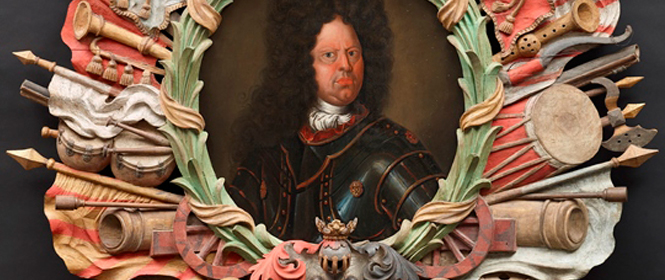
THE HIDDEN FACE
Our painting restorer Mathias Lang studied the headstone of an 18th century general – and discovered his true countenance.
The true face of General Hanns Wilhelm von Thoss had lain hidden for a long time. When examining the headstone, which had been acquired from a private collection in 2013, Mathias Lang, painting restorer at Deutsches Historisches Museum, noticed that the painting and the frame had been completely redone. Someone had painted over the entire face and background of the portrait. The portrait itself seemed devoid of expression and displayed a painting technique that was unusual for the first half of the 18th century (when the painting was completed). What’s more, some of the original elements of the frame had been remounted in an incorrect position, whereas other parts were missing completely and a grey slurry covered the entire coloured mount.
X-RAY BRINGS SURPRISING FIND TO LIGHT
Head of Restoration, Martina Homolka, and her colleague Mathias Lang decided to get to the bottom of the mystery by commissioning an X-ray. ‘This X-ray made it clear that the painting contained further layers. Lurking beneath the benign countenance was the face of an older and seemingly imperious man,’ remembers Mathias Lang. As the overpainting was clearly a modern alteration that could not have been all that old, the restoration specialists decided – in consultation with Dr Leonore Koschnik, Head of Applied Arts and Graphics – to uncover the original portrait.
AN IMPERIOUS GENERAL HIDDEN BEHIND AN ATTRACTIVE YOUNG MAN
Comparing the ‘before’ and ‘after’ portraits illustrates how dramatically the face had changed. Even Mathias Lang was surprised by the huge difference in personality that the original revealed: ‘Clearly, the idea was to make the subject seem more attractive. The decision to overpaint the actual face of General von Thoss with that of a friendly-looking young man was probably done for reasons of taste, thus toning down and glossing over the harsh and imperious aspects of his personality.’
CANNONBALLS, FLAGS AND COATS OF ARMS AS PART OF THE BAROQUE CULTURE OF REMEMBRANCE
Martina Homolka, who restored the frame, didn’t just clean and retouch the object, but also returned the incorrectly mounted items on the frame to their original places and reconstructed some of the elements whose form could still be discerned. The frame is adorned with war trophies such as cannons and cannonballs, gunpowder kegs, lances and spears, and flags and coats of arms – as was typical for the culture of remembrance surrounding Baroque rulers and commanders in the early 18th century. Sculptors were commissioned to provide decorative works appropriate for the newly accumulated arsenals, whereas painters and engravers produced images dedicated to war heroes.
The portrait, complete with decorative frame, was originally intended for the grave of Hanns Wilhelm von Thoss in the church of Lichtenau, a small town on the banks of the Upper Rhine. Thoss, who was born in Großwerther in what is now Thuringia, embarked on a military career at the tender age of 15 and died in 1706 in the town of Stollhofen, just a few miles from the Upper Rhine and the border with France. His widow, Magdalena Sidonie von Thoss, probably only commissioned the headstone, with its portrait of the deceased, for the Thoss family grave in 1715, after the end of the War of the Spanish Succession.